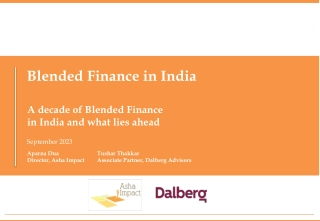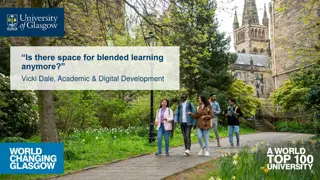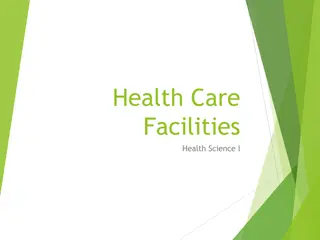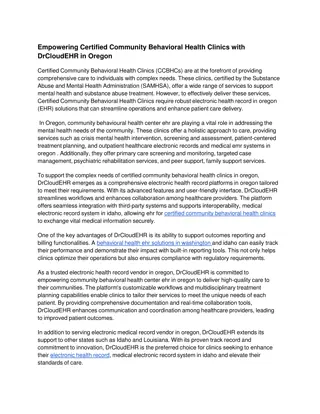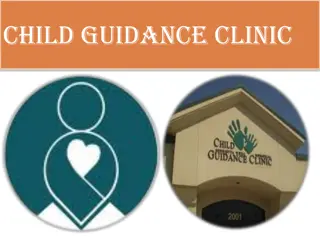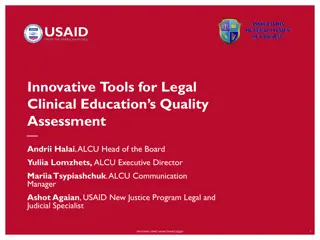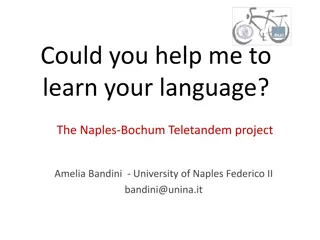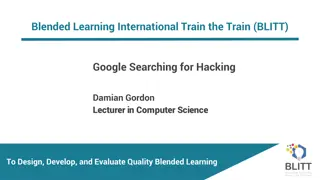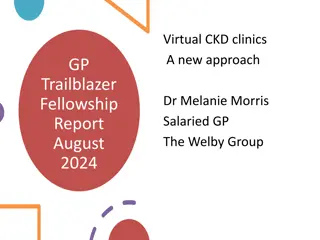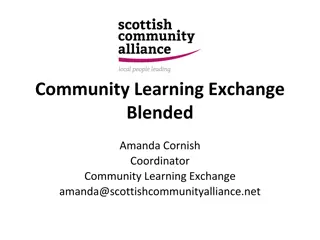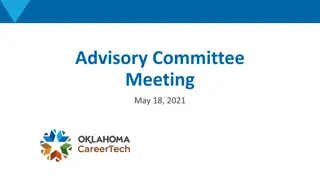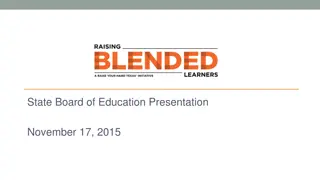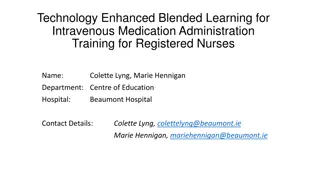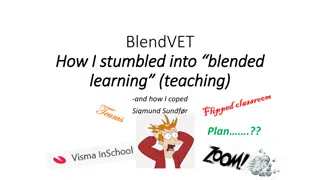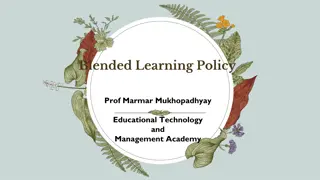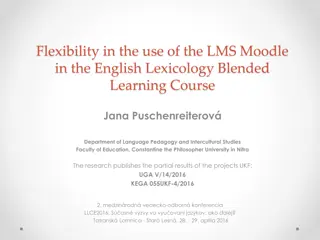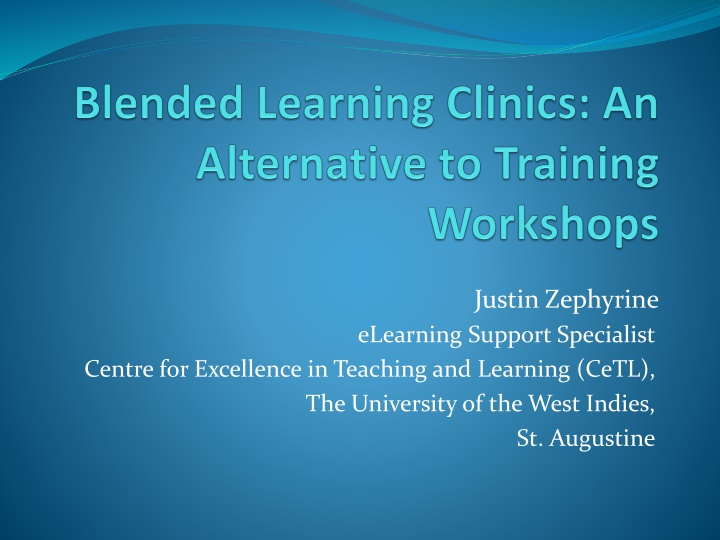
Enhancing Blended Learning Strategies at the University of the West Indies
Explore the implementation of Blended Learning (BL) initiatives at the University of the West Indies (UWI), St. Augustine campus, focusing on strategies such as face-to-face and online course delivery, workshops, and Blended Learning Clinics (BLCs). Discover the benefits, challenges, and outcomes of integrating technology into teaching practices to promote active and collaborative learning experiences.
Download Presentation

Please find below an Image/Link to download the presentation.
The content on the website is provided AS IS for your information and personal use only. It may not be sold, licensed, or shared on other websites without obtaining consent from the author. If you encounter any issues during the download, it is possible that the publisher has removed the file from their server.
You are allowed to download the files provided on this website for personal or commercial use, subject to the condition that they are used lawfully. All files are the property of their respective owners.
The content on the website is provided AS IS for your information and personal use only. It may not be sold, licensed, or shared on other websites without obtaining consent from the author.
E N D
Presentation Transcript
Justin Zephyrine eLearning Support Specialist Centre for Excellence in Teaching and Learning (CeTL), The University of the West Indies, St. Augustine
Outline of Presentation Context of Study (Blended Learning at the UWI) 1. 2. Objectives of Research 3. Research Methods 4. Research Data and Discussion 5. Conclusion
BL at the UWI [ ] the appropriate organisation of face to face approaches with web-based and other information and communication technologies for advancing student- oriented, active, collaborative teaching-learning processes (The University of the West Indies, 2012, p.1)
BL at the UWI a programme that comprises a substantial number (between 50-75%) of courses, which are offered using a combination of face-to-face and online modes of delivery (p 84). Thurab-Nkhosi (2013)
Implementation of Policy Vision + Action = Fruition
BLWs Conducted in a computer laboratory Provided hands-on training in ICTs Catered for 30-35 persons per workshop Campus-wide invitation
BLWs Assessing our Practice Pros Catered to a large number of people Allowed for networking among staff Provided opportunities for collaboration
BLWsBut Scheduling conflicts Awareness/promotion Commitment Low attendance (3-4 per workshop) High costs Minimal impact
BLCs Blended Learning Clinics (BLCs) are one-on-one consultations in which Educators are provided with hands-on experience in a myriad of technology tools under the personal supervision of a training specialist who also provides guidance in the use of these tools to the specific contexts and conceptual frameworks of the Educator s course curriculum.
BLWs vs BLCs Blended Learning Number of Total Number of Training in 2014 Training Sessions Participants BLWs 9 64 BLCs 45 45 Fig1. Shows the attendance for the total number of BLCs against BLWs
Objective of Study What were students experiences in courses taught by Lecturers who were (not) exposed to BLCs? What were Lecturers course experiences before and after completing a series of BLCs? In what way has technology been integrated into courses before and after BLCs?
Research Methods Quantitative SECL Survey Reports Qualitative Informal Structured Interviews Often the purpose of triangulation in specific contexts is to obtain confirmation of findings through convergence of different perspectives. The point at which the perspectives converge is seen to represent reality (Jakob, 2001).
1. What were students experiences in courses taught by Lecturers who were (not) exposed to BLCs? The SECL Survey/Reports
Department Semester Number of Percentage of Student-responses student-response Life Sciences 1 493 39 Life Sciences 2 246 38 Electrical & Computer Engineering 1 80 25 Geomatics Eng & Land Management 1 33 22 Mech & Manufacturing Eng 1 128 26 Mech & Manufacturing Eng 2 116 27 Computing & IT 2 69 21 Chemistry 1 134 33 Chemistry 2 106 25 Medical Sciences- Optometry 1 5 8 Agricultural Economics & Extension 2 139 26 Film 2 23 26 Fig 2. Shows the percentage of students who strongly agreed that online course components were useful in 2013/2014.
The vision of the policy [ ] the appropriate organisation of face to face approaches with web-based and other information and communication technologies for advancing student- oriented, active, collaborative teaching-learning processes (The University of the West Indies, 2012, p.1).
2. What were Lecturers course experiences before and after completing a series of BLCs? The Interviews
Why ICTs and Blended Learning? Because it is less cumbersome for lecturers and it pleases students and other stakeholders better, and the students are the customers we ought to please. (Interviewee E, personal communication, March 2015) It facilitates classes of large numbers (for e.g. 500-900 students). It also helps with management of content and effective communication with students across faculties. Additionally it helps in administering quizzes [ ] for large classes and provides students feedback and statistics immediately. (Interviewee A, personal communication, March 2015)
Why ICTs and Blended Learning? To keep up and be relevant with 21st century education via online tutorials etc (Interview C, personal communication, March 2015) To keep pace with new technology-oriented life-style of modern young students [ ] to utilize the [face-to-face] sessions more effectively for engaging students and to make [teaching and learning] more flexible. (Interviewee D, personal communication, March 2015)
The Use of ICTs Before BLCs Figure 3. Illustrates the Progress of Technology-Use by Lecturers Before BLCs at the UWI, St. Augustine
How have BLCs helped you? it encouraged me to change my teaching and learning environment and to be more technology oriented (Interviewee D, personal communication, March, 2015), the attitude of the Guide/Helper/Facilitator was helpful, understanding, insightful, empathetic of the situation and was willing to help [ ] the environment was always there to come back to practice and learn helped me to acquire competence[ ] (Interviewee E, personal communication, March, 2015), gave a better understanding [ ], practice alternatives to using [the LMS] more effectively (Interviewee B, personal communication, March 2015) provided further insight on things from a student s perspective (Interviewee A, personal communication, March, 2015).
Increased Student Engagement since BLCs Observable behaviours such as: The students responses in online fora and face- to-face discussions 1. 2. The feedback from their students regarding online notes and activities 3. The improved teacher-student rapport
BLCs or BLWs? BLCs because it is effective to my unique circumstances I would have been lost in the workshops. The BLCs [are] more convenient for my timetable/schedule and it helps me to overcome the fear of technology. Workshops cater to more people (reaches more people) but not as effective as BLCs and the timing of the workshops is often problematic (Interviewee E, personal communication, March, 2015)
BLCs or BLWs? Both BLCs help you to better understand things that one may be ashamed to ask in front of other colleagues and it would be better to meet individual needs. But the training workshops allowed for sharing of ideas and experiences (Interviewee B, personal communication, March 2015)
Impact Features of BLCs The ease of feedback and ready solutions to problems and concerns as well as the availability of the consultant (Interviewee A, personal communication, March 2015) The Guide [or consultant] training despite the limited office hours, space and resources. The person [or consultant] and the personality of the person made the difference [for example, created] a comfortable environment to learn (Interviewee E, personal communication, March 2015).
In what way has technology been integrated into courses before and after BLCs? Nominal Checklist
What the Checklist Revealed Empty Course Shell Shell with resources Shell with resources Shell with Activities Shell with activities Embedded sites/apps
Another Look at BLWs vs BLCs BLWs BLCs Low attendance High expenses Scheduling conflicts Long preparation time Quick Intensive Impactful Inexpensive Convenient Private
A Closer Look at BLCs Practice Insight Advice BLCs
BLWs or BLCs? BLCs BLWs
Blended Learning Clinics (BLCs): An Alternative to Blended Learning Workshops (BLWs)
References Barr, R. B., & Tagg, J. (1995). From Teaching to Learning -- A New Paradigm for Undergraduate Education. Change, 27(6). Bates, A. W. (2000). Managing technological change - Strategies for college and university leaders. San Fransisco: Jossey Bass. Bransford, J. D., Brown, A. L., & Cocking, R. R. (2000). How people learn: Brain, mind, experience, and school. Washington, DC: National Academy Press. Collins, J. W., 3rd, & O'Brien, N. P. (Eds.). (2003). Greenwood Dictionary of Education. Westport, CT: Greenwood. Dziuban, C. D., Hartman, J. L., & Moskal, P. D. (2004). Blended learning, Educause Center for Applied Research, Research Bulletin, 7, Retrieved from http://www.educause.edu/ir/library/pdf/ERB0407.pdf. Graham, Charles. (2004). Blended Learning Systems: Definition, Current Trends and Future Directions. Pfeiffer: USA. Retrieved from http://www.click4it.org/images/a/a8/Graham.pdf
References Huba, M. E., & Freed, J. E. (2000). Learner-Centered Assessment on College Campuses: Shifting the Focus from Teaching to Learning. Needham Heights, MA: Allyn & Bacon. Hussein, Ashatu. (2009). The Use of Triangulation in Social Sciences Research: Can qualitative and quantitative methods be combined? Journal of Comparative Social Work. Retrieved from http://jcsw.no/local/media/jcsw/docs/jcsw_issue_2009_1_8_arti cle.pdf Jakob, Alexander (2001 February), On the Triangulation of Quantitative and Qualitative Data in Typological Social Research: Reflections on a Typology of Conceptualizing 'Uncertainty in the Context of Employment Biographies, Forum: Qualitative Social Research, Volume 2, Number 1. Jick, Todd. (1979). Mixing Qualitative and Quantitative Methods: Triangulation in Action, Administrative Science Quarterly, Volume 24, Number 24, 602-611.
Reference Lewis, Barbara A., & MacEntee, Virginia M. (2005). Learning Management Systems Comparison. Proceedings of the 2005 Informing Science and IT Education Joint Conference. Retrieved January 15, 2011, from http://www.informingscience.org/proceedings/InSITE2005/P03f55Lewis.pdf Oblinger, Diana. (2003, July/August). Understanding the New Students: Boomers, Gen-Xers and Millennials. Educause Review. OECD (2005). Teachers matter. Attracting, Developing and Retaining Effective Teachers. Paris: OECD http://www.oecd.org/document/9/0,3343,en_2649_39263231_11969545_1_1_1_1,00.html Pankin, J., Roberts, J., & Savio, M. (2012). Blended Learning at MIT. http://web.mit.edu/training/trainers/resources/blended_learning_at_mit.pdf
References Pinder-Gover, Tershia and Groscurth Christopher. (2009). Principles for Teaching the Millennial Generation: Innovative Practices of U-M Faculty. CRLT Occasional Papers. USA: University of Michigan, Centre for Research on Learning and Teaching. Retrieved from http://www.crlt.umich.edu/sites/default/files/resource_files/CRLT_no26.pdf Prensky, M. (2001). Digital natives, digital immigrants. On the Horizon, 9(5). The University of the West Indies (2012). The blended learning policy of the St Augustine Campus. St. Augustine, Trinidad: The University of the West Indies, Instructional Development Unit. Salmon, G. (2000). E-Moderating - The key to teaching and learning online. London: Kogan Page. Thurab-Nkhosi, Dianne. (2013, April). Blended learning at The University of the West Indies, St. Augustine: A first look at policy implementation. Caribbean Teaching Scholar Vol. 3, No.1. The University of the West Indies. Retrieved from http://journals.sta.uwi.edu/cts/index.asp?action=fullTextPermaLink&articleId=362&galleId=311
References Yeasmin, Sabina and Rahman, Ferdousour (2012, September). Triangulation Research Method as the Tool of Social Science Research. BUP Journal, Vol. 1, Is. 1. Retrieved from http://www.bup.edu.bd/journal/154-163.pdf

